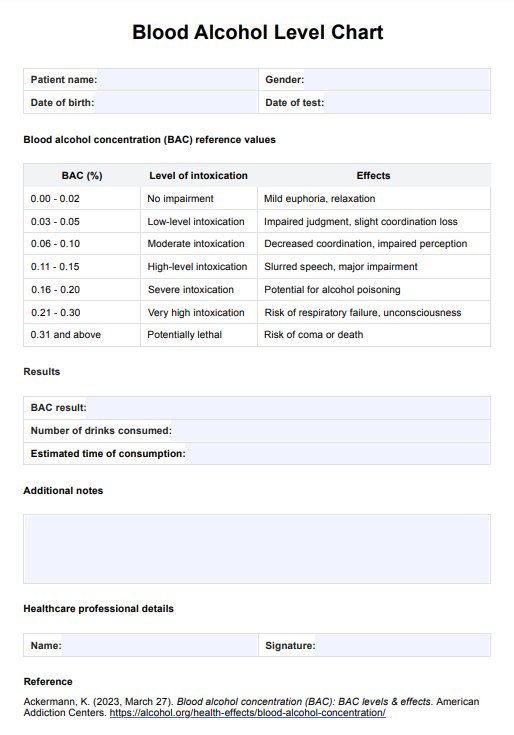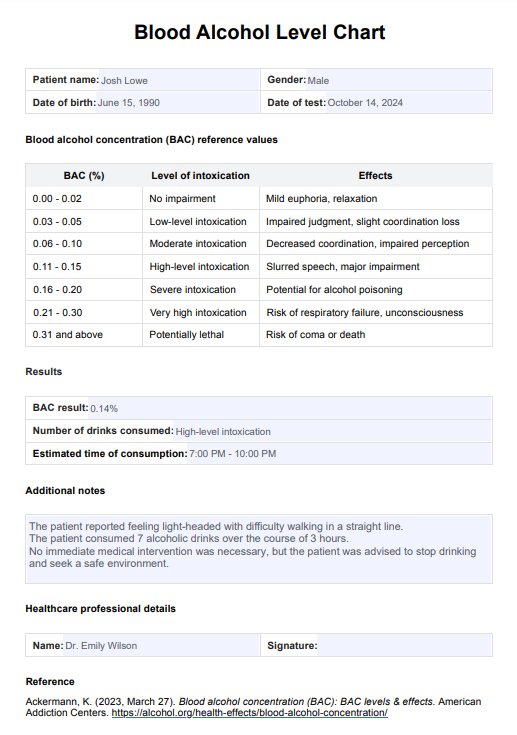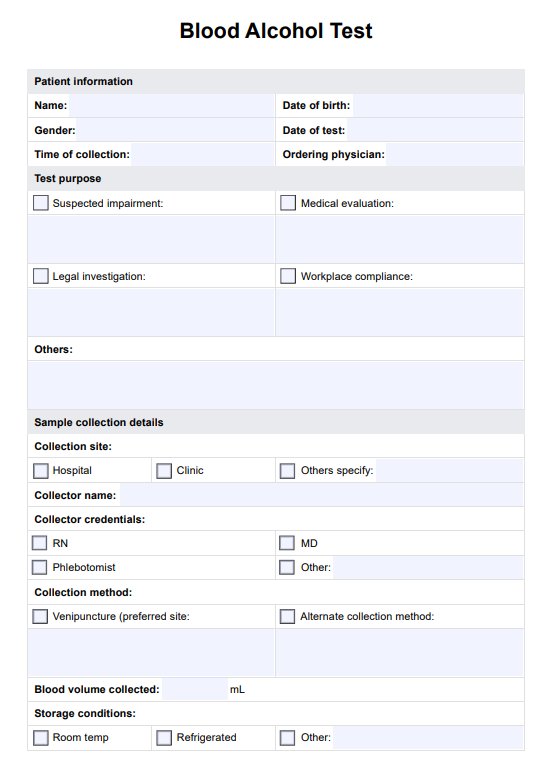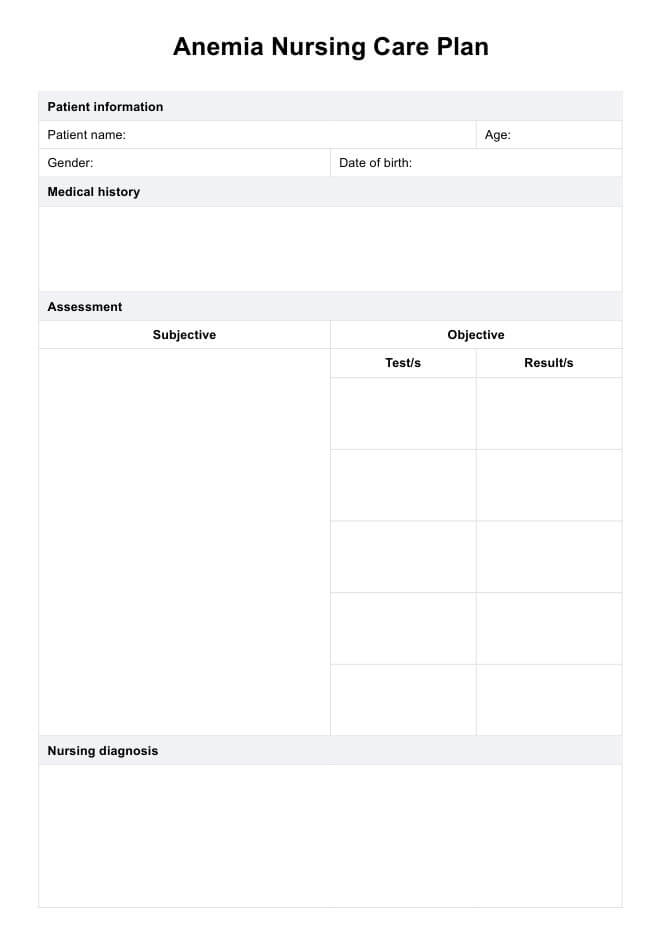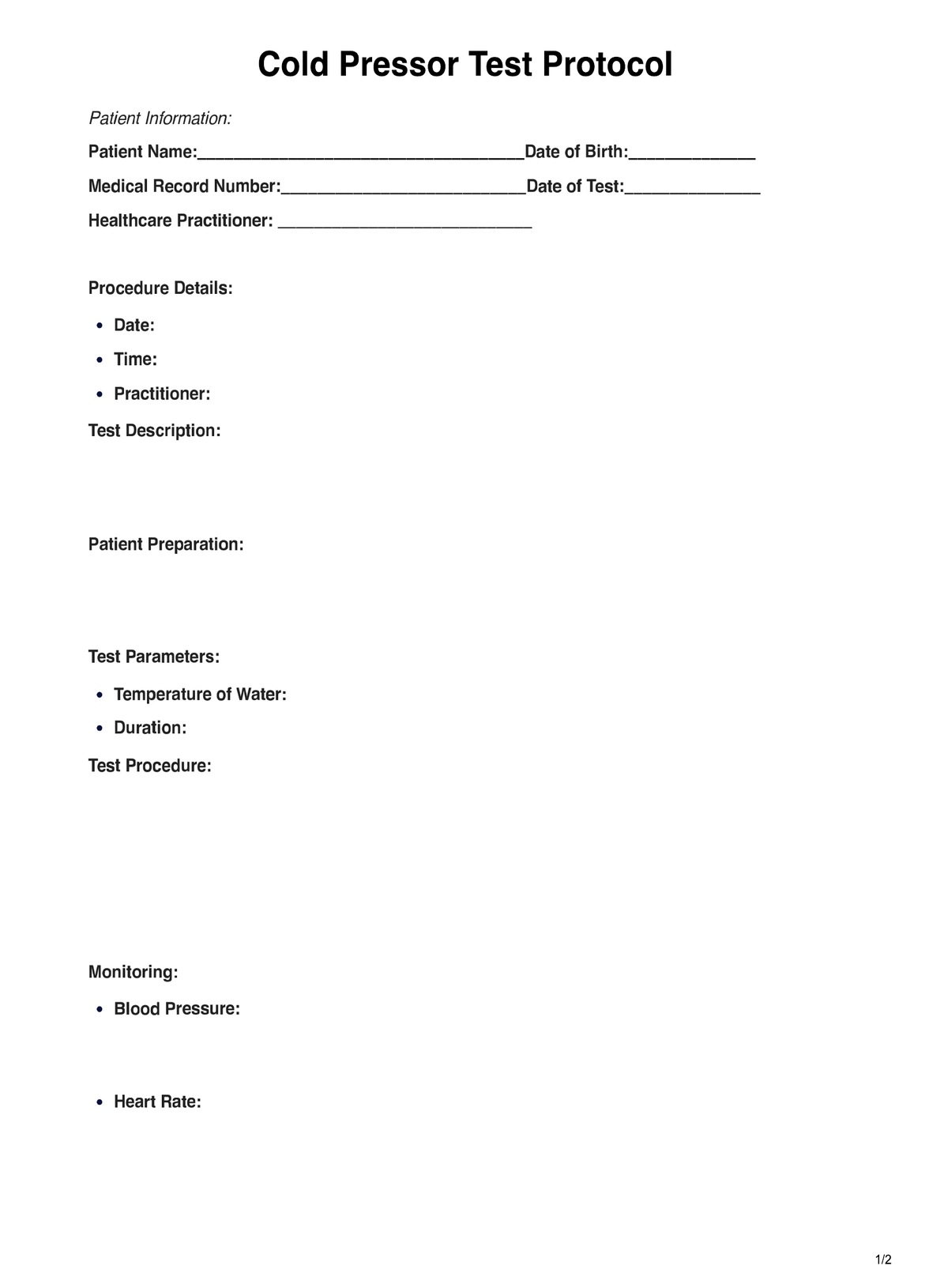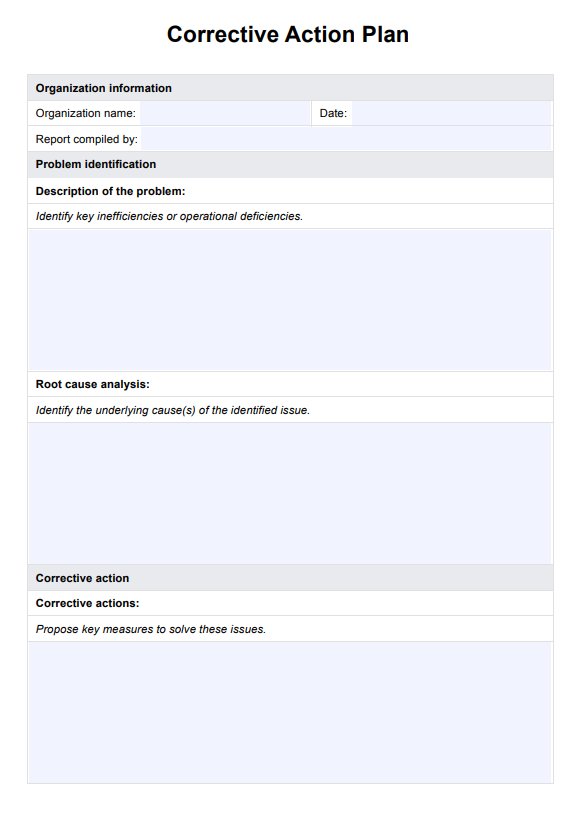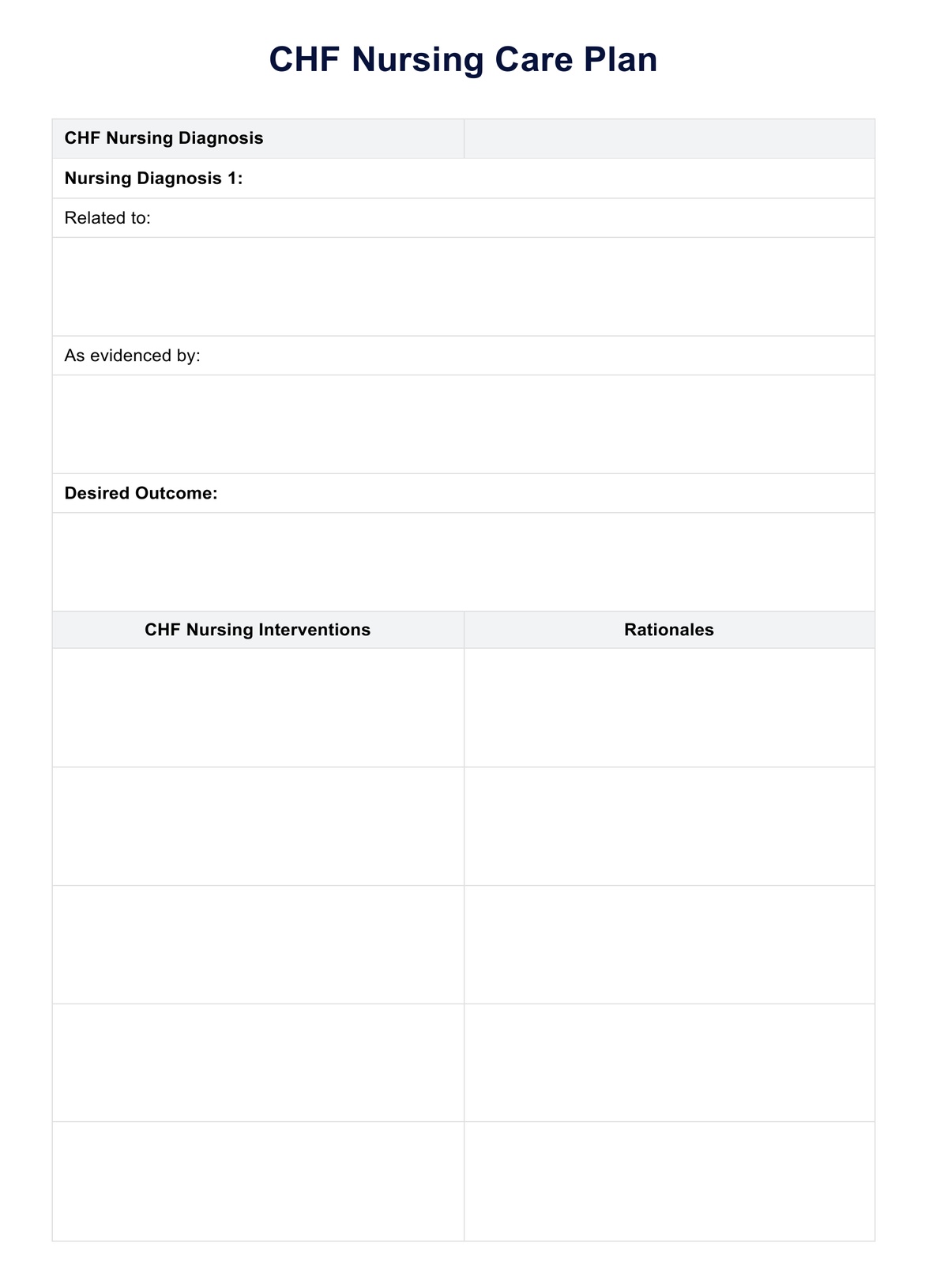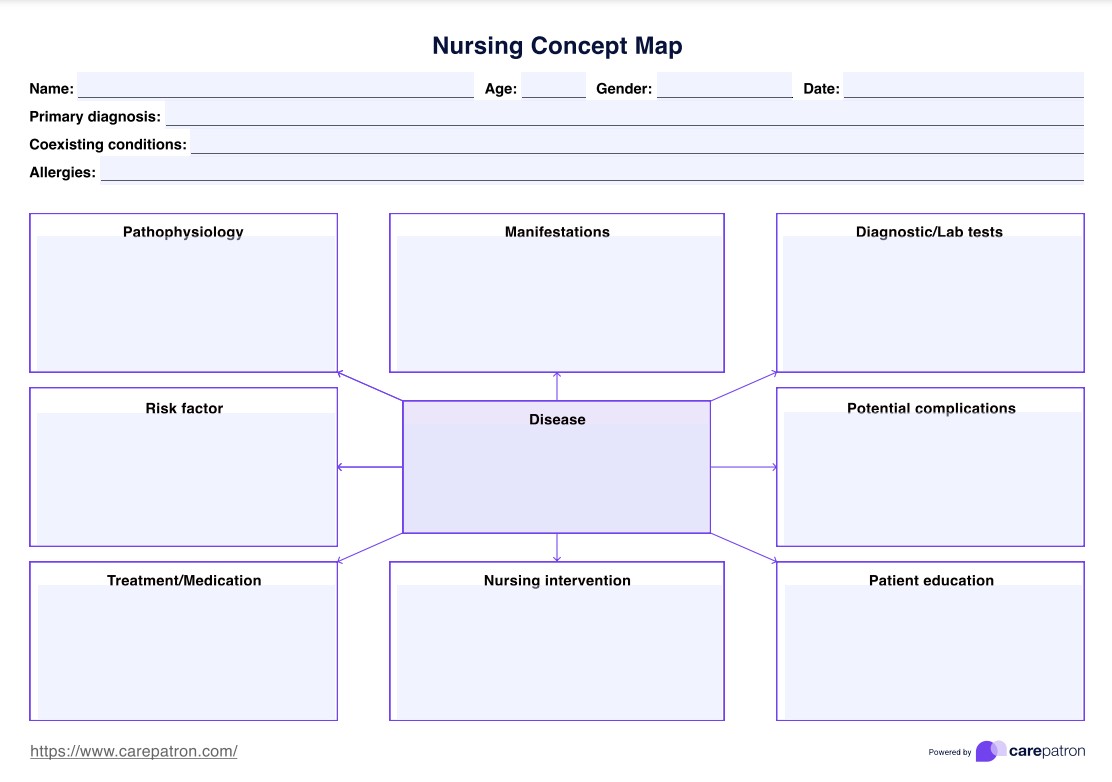Blood Alcohol Level Chart
Learn about Blood Alcohol Level Charts to learn about alcohol intoxication levels and use our Blood Alcohol Level Chart template for your work.


What is the relationship between alcohol and health?
The relationship between alcohol and health is complex, influenced by how much alcohol an individual consumes and several factors such as age, gender, genetics, and overall health. When people drink alcohol in moderation, there may be certain benefits, such as relaxation or limited use for medical purposes.
However, excessive alcohol consumption can lead to serious health risks, including alcohol intoxication and, in severe cases, alcohol poisoning. The effects of alcohol vary; consuming the same amount can result in different outcomes for each individual.
Symptoms like slurred speech, altered mood, and impaired coordination appear after just one drink for some, while others may need more to feel these effects. Long-term excessive drinking can result in chronic diseases, liver damage, and a major loss of cognitive function.
Furthermore, alcohol is a significant contributor to drunk driving accidents and fatalities. Urine tests and other medical assessments can detect alcohol in the system, and combining alcohol with other drugs amplifies the risk of dangerous side effects. Being mindful of how much one consumes is key to reducing the risk of long-term health issues.
Blood Alcohol Level Chart Template
Blood Alcohol Level Chart Example
What is a Blood Alcohol Level Chart?
A Blood Alcohol Level Chart is a valuable tool that illustrates the relationship between alcohol consumption and blood ethanol concentration, helping individuals and healthcare providers understand the effects of alcohol on the body. This chart typically shows how different blood alcohol levels correlate with specific behaviors, such as impaired judgment, decreased coordination, and altered reaction time. It also indicates the legal limits for blood alcohol concentration, which varies by region but often signifies when a person is considered legally intoxicated.
The chart generally reflects the whole blood ethanol content after consuming standard drinks, providing insights into how quickly blood alcohol concentration can rise based on the amount of alcohol consumed. For instance, urine testing and a chemical test can further assess a person’s alcohol levels after drinking and ethanol toxicity. Understanding these levels is crucial, as even moderate drinking can lead to severe consequences, including respiratory arrest and impaired decision-making.
While individuals who consume alcohol moderately may offer some health benefits, awareness of one's blood ethanol concentration is essential to ensure safe and responsible drinking habits, ultimately promoting safer environments for all.
What are blood alcohol concentration (BAC) levels?
Blood alcohol concentration (BAC) is a critical measure used to assess the level of alcohol in an individual's bloodstream, expressed as a percentage. Understanding BAC values is essential for recognizing the effects of alcohol consumption and the associated risks.
Here are the BAC reference values and its effects according to Ackermann (2023):
- 0.02%: Mild relaxation, altered mood, and impaired judgment begin to manifest.
- 0.05%: Exaggerated behavior, loss of small muscle control (e.g., blurred vision).
- 0.08%: Legal limit for driving in most U.S. states; significant impairment in coordination, balance, and reaction times.
- 0.10%: Marked impairment in motor skills and judgment; potential for aggressive behavior.
- 0.20%: Severe confusion and disorientation; may require assistance to stand or walk.
- 0.30%: Risk of stupor; mental and physical functions are severely impaired.
- 0.40% and above: Potentially fatal; risk of coma or death due to respiratory failure
How does it work?
Using Carepatron's Blood Alcohol Level Chart is a straightforward process that helps healthcare professionals provide clear guidance to patients regarding alcohol consumption and its effects. Here’s how to effectively utilize the chart in clinical practice:
Access the chart
To begin, users can easily find the Blood Alcohol Level Chart template within this guide. This accessible resource allows healthcare professionals to quickly reference alcohol levels and their corresponding effects, facilitating informed discussions with patients about safe drinking practices.
Introduce the chart to the patient
Once the chart is accessed, introduce it to the patient during consultations. Explain the significance of the chart in understanding blood alcohol concentration and its implications on health and behavior. This helps patients visualize how their drinking habits can affect their well-being and encourages open dialogue.
Provide patient education
Utilize the chart as a teaching tool to educate patients about the effects of different blood alcohol levels. Discuss how standard drinks impact blood ethanol concentration, emphasizing concepts like legal limits and impaired judgment. This empowers patients to make informed decisions about their alcohol consumption and understand the risks involved.
Establish next steps
After reviewing the chart, establish actionable next steps with the patient. This may include setting limits on alcohol consumption, scheduling follow-up appointments for further discussions, or providing resources for alcohol support programs. Clear next steps ensure ongoing support and accountability for patients aiming to manage their alcohol intake effectively.
How is blood alcohol concentration (BAC) measured?
Blood alcohol concentration is a measure of the amount of alcohol in a person’s bloodstream after consuming alcohol. It helps determine how impaired someone may be after drinking alcohol.
Blood samples
A blood test is one of the most accurate ways to measure blood alcohol content. A healthcare provider draws a blood sample and tests it in a lab to determine the exact blood alcohol level. This method is highly precise, but it is also invasive and may not provide immediate results. It's often used when precise readings are crucial, such as in medical or legal situations where too much alcohol may be involved.
Urine and saliva tests
Urine and saliva tests are less invasive ways to measure blood alcohol content. These tests can estimate blood alcohol levels, though they are less accurate than a blood test. Urine tests, in particular, measure the alcohol content excreted from the body, which may not directly correlate with real-time BAC levels. They are often used for post-incident assessments, like after consuming alcohol.
Breathalyzers
Breath alcohol tests, or breathalyzers, are the most commonly used method to measure BAC, especially by law enforcement. These portable devices estimate blood alcohol content by analyzing the alcohol in a person’s breath. The results provide an immediate and reasonably accurate indication of BAC, often helping to determine how many drinks a person has consumed. Breathalyzers are quick and noninvasive, making them widely used for roadside sobriety checks.
Reference
Ackermann, K. (2023, March 27). Blood alcohol concentration (BAC): BAC levels & effects. American Addiction Centers. https://alcohol.org/health-effects/blood-alcohol-concentration/
Commonly asked questions
Being three times over the legal limit of alcohol refers to a blood alcohol concentration (BAC) that is three times the standard legal threshold for driving. In most places, the legal limit is set at 0.08%. Therefore, three times this limit would result in a BAC of 0.24%.
Your blood alcohol content (BAC) after three drinks varies by weight and gender. For example, a 180 lbs male may have a BAC of about 0.063%. This decreases by approximately 0.015% per hour as the body metabolizes alcohol. Individual responses to alcohol can differ significantly. Always drink responsibly.
Blood alcohol concentration (BAC) does indeed lessen over time, but it is important to understand the mechanisms behind this process. The body metabolizes alcohol primarily through the liver, using the enzyme alcohol dehydrogenase. On average, BAC decreases at a rate of approximately 0.015 g/100 mL per hour. This means that for a person with a BAC of 0.08, it would take about 5 to 6 hours to return to zero.


